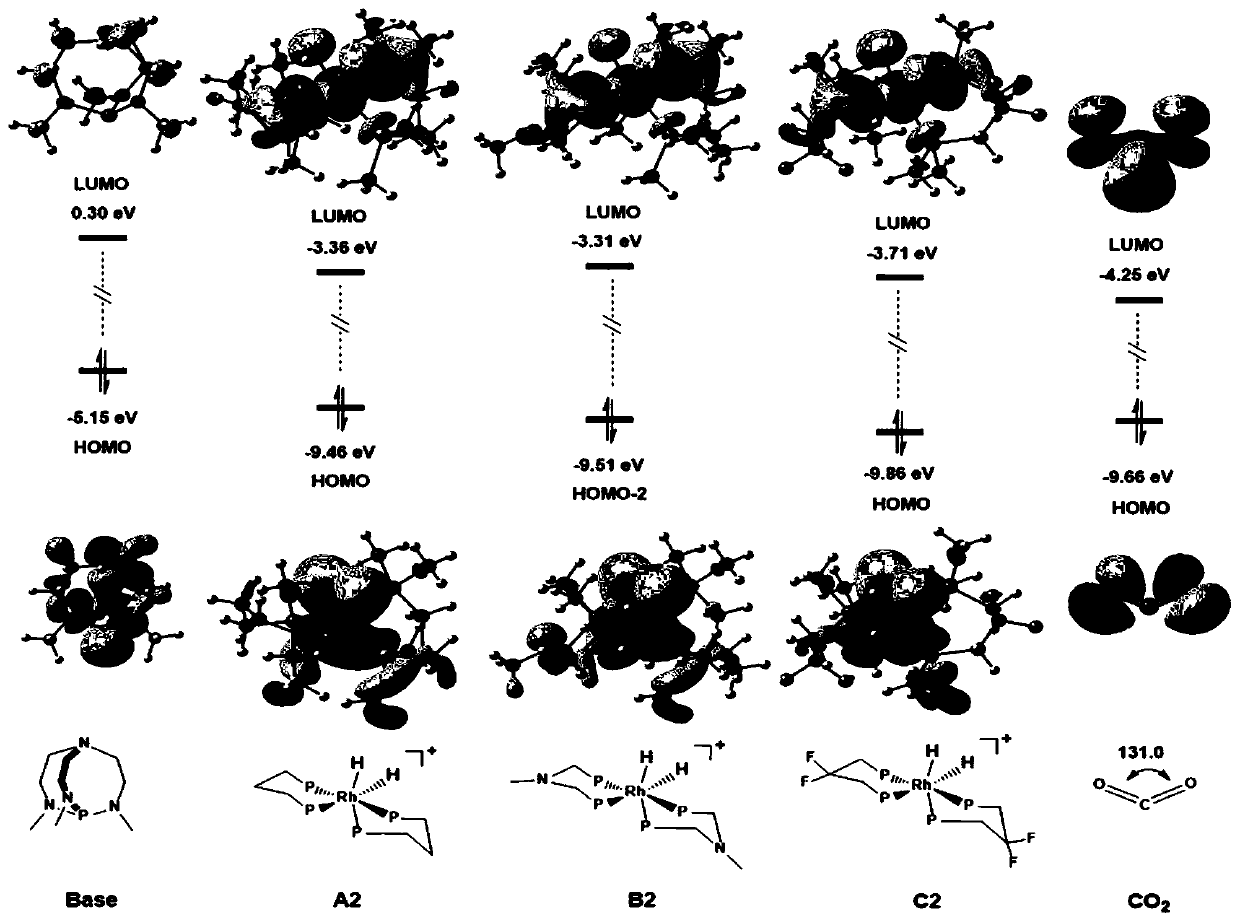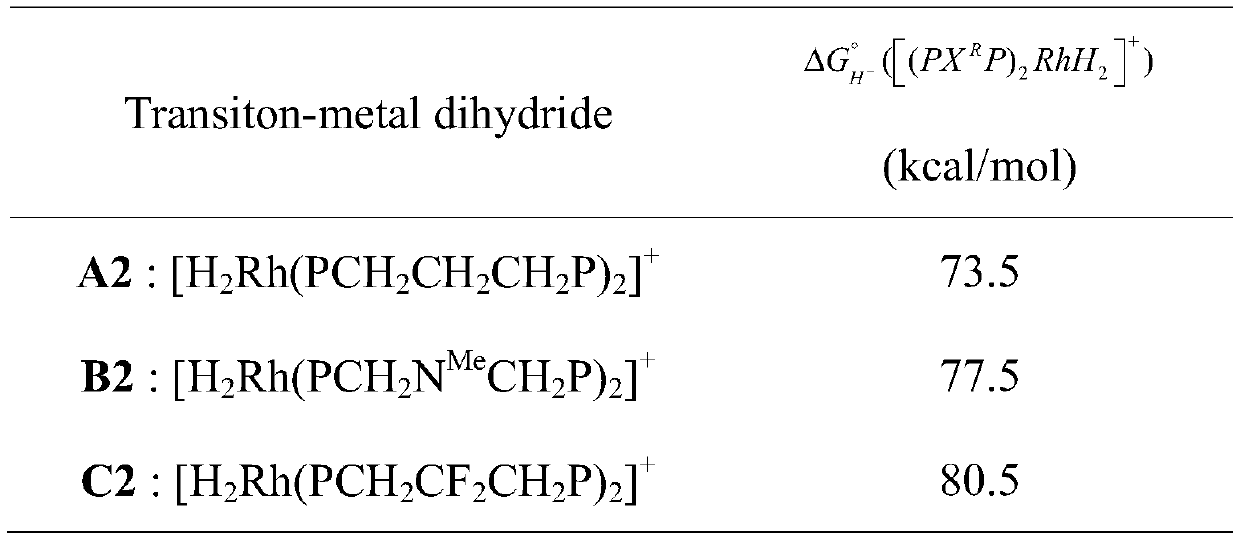A compound and its application
A compound, hydrogenation reaction technology, applied in the preparation of rhodium organic compounds, platinum group organic compounds, organic compounds, etc., can solve the problems of low catalytic efficiency, long reaction time, slow rate-determining step speed, etc., to improve catalytic efficiency, The effect of saving reaction time and reducing reaction cost
- Summary
- Abstract
- Description
- Claims
- Application Information
AI Technical Summary
Problems solved by technology
Method used
Image
Examples
Embodiment 1
[0017] Embodiment 1: Catalyst Rh (PCH 2 CF 2 CH 2 P) 2 ] + preparation of
[0018] First, 1,2-dimethoxyfluoromethane was dissolved in glacial acetic acid. Under cooling in an ice-water bath, add a solution of bromine and a small amount of glacial acetic acid into the reaction flask dropwise through a constant-pressure dropping funnel within 3 hours. After reacting at room temperature for 24h, the reaction solution was poured into a 100ml ice-water bath and washed with CH 2 CI 2 Extract three times and separate the organic layer. The organic layer was washed with water and saturated brine, anhydrous MgSO 4 Dry and filter the filtrate to remove CH 2 CI 2 Afterwards, it was distilled under reduced pressure, and the fraction at 178°C and 1 333 Pa was collected to obtain 4-bromo-1,2-dimethoxymethane as a colorless liquid. Under nitrogen protection, 4-bromo-1,2-dimethoxymethane and THF dehydrated and deoxygenated were added into a dry two-necked flask. Slowly add 5.2ml n...
Embodiment 2
[0019] Embodiment 2: Rh (PCH 2 CF 2 CH 2 P) 2 ] + Catalytic carbon dioxide hydrogenation experiment
[0020] The reaction conditions are: solvent: 40mL ethanol; base (Verkade's base): 0.5mmol Catalyst: 0.1mmol Rh(PCH 2 CF 2 CH 2 P) 2 ] + ; Reaction temperature: 85°C; Reaction pressure: H 2 : 4.0MPa; Reaction time 1h. After completion of the reaction, 30.10 mmol of acetic acid was produced, and the conversion number was 1405.
[0021] Catalyst Rh (PCH) prepared in embodiment 1 2 CF 2 CH 2 P) 2 ] + catalytic CO 2 During the hydrogenation reaction, the reaction energy barrier can be reduced to 18.0kcal / mol, which catalyzes CO 2 The energy barrier diagram of the hydrogenation reaction is shown in figure 1 As shown, the electron-withdrawing group on the catalyst ligand leads to the lack of electrons in the metal center, resulting in a decrease in the binding electron ability of hydrogen on the metal, so it is easily taken away by the base, so the activation ener...
Embodiment 3
[0025] Embodiment 3: Catalyst Rh (PCH 2 CH 2 CF 2 CH 2 CH 2 P) 2 ] + preparation of
[0026]First, 1,2-dimethoxyfluoroethane was dissolved in glacial acetic acid. Under cooling in an ice-water bath, add a solution of bromine and a small amount of glacial acetic acid into the reaction flask dropwise through a constant-pressure dropping funnel within 4 hours. After reacting at room temperature for 24h, the reaction solution was poured into a 100ml ice-water bath and washed with CH 2 CI 2 Extract three times and separate the organic layer. The organic layer was washed with water and saturated brine, anhydrous MgSO 4 Dry and filter the filtrate to remove CH 2 CI 2 Afterwards, it was distilled under reduced pressure, and the fraction at 178°C and 1 333 Pa was collected to obtain 4-bromo-1,2-dimethoxyethane as a colorless liquid. Under nitrogen protection, 4-bromo-1,2-dimethoxyethane and THF dehydrated and deoxygenated were added into a dry two-necked flask. Slowly add...
PUM
 Login to View More
Login to View More Abstract
Description
Claims
Application Information
 Login to View More
Login to View More - R&D
- Intellectual Property
- Life Sciences
- Materials
- Tech Scout
- Unparalleled Data Quality
- Higher Quality Content
- 60% Fewer Hallucinations
Browse by: Latest US Patents, China's latest patents, Technical Efficacy Thesaurus, Application Domain, Technology Topic, Popular Technical Reports.
© 2025 PatSnap. All rights reserved.Legal|Privacy policy|Modern Slavery Act Transparency Statement|Sitemap|About US| Contact US: help@patsnap.com



